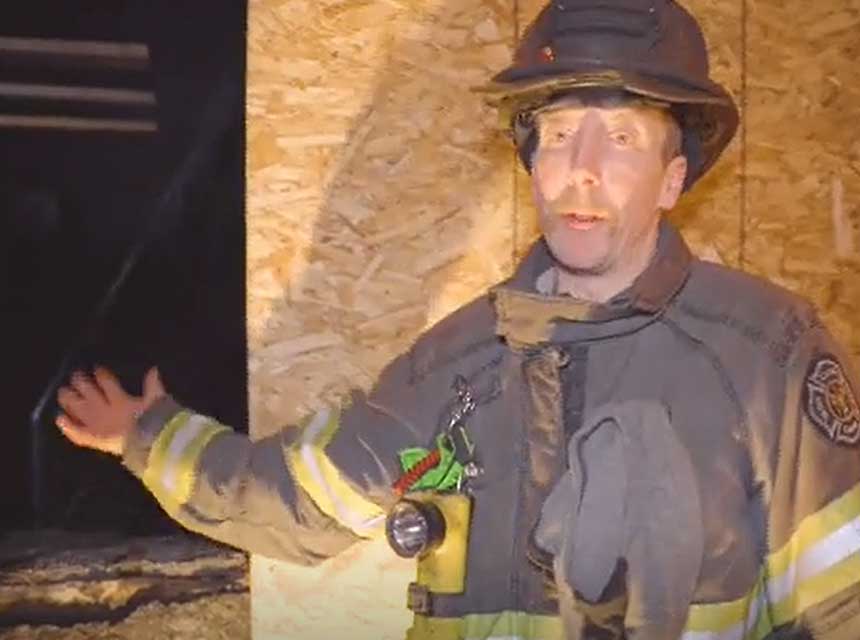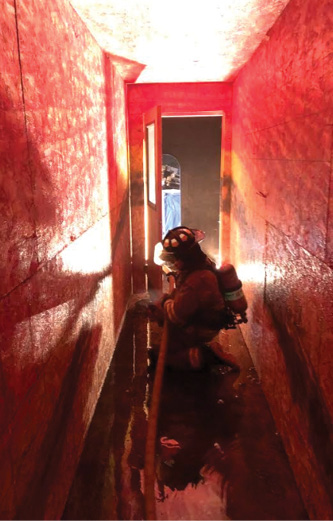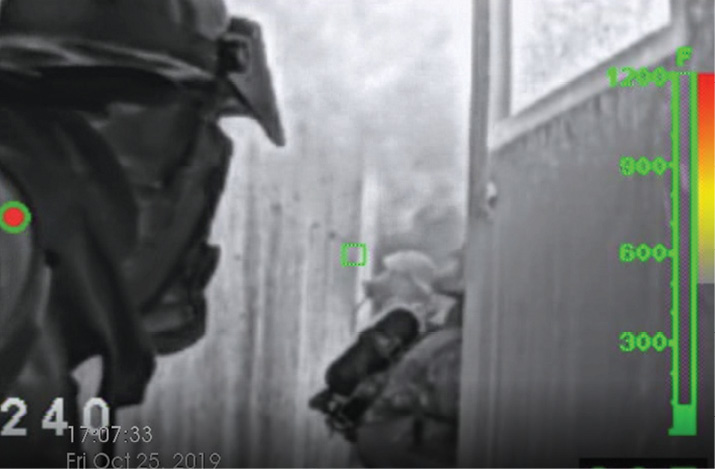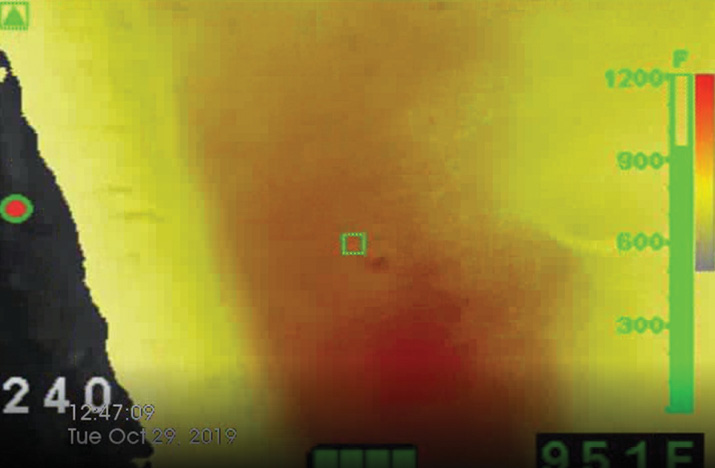
Recently, I taught the fire attack portion of our fire academy at Capital City Fire-Rescue in Juneau, Alaska. Previous academy classes have used several partial pallets in a burn pan or, sometimes, just a blinking flashlight in a traffic cone on “live fire” training days. These evolutions are useful for learning the roles and responsibilities of the different positions on the hoseline, but they do not represent what it’s like to operate at a structure fire. As the lead instructor, I wanted to offer the students something that was more realistic.
Over the past several years, I have attended multiple “Nozzle Forward” classes and have become comfortable with hose and nozzle advancement skills. Last year, I participated in a full week of test burns with Aaron Fields and the Nozzle Forward cadre in multiple acquired structures with real-life combustible materials in real-life quantities. That week of test burns showed the effectiveness of the Nozzle Forward curriculum, which has now been validated by the recent Underwriters Laboratories (UL) Study of the Impact of Fire Attack Utilizing Interior and Exterior Streams on Firefighter Safety and Occupant Survival.
RELATED FIREFIGHTER TRAINING
Back-to-Basics Drilling for the Engine Company, Part 1 | Part 2
Modern House Fires: Effects of Research on Strategy and Tactics
Modern House Fires Warrant Tactical Agility
For our fire academy, I had two distinct goals: (1) prepare the students to pass the practical exam, and (2) create a training environment that would replicate what I experienced during the test burns and to show the effectiveness of the “push” vs. the “hit-and-move” fire attacks.
Limitations of Current Training Structures
Like many older concrete burn structures, ours is showing its age and has started to spall in places. We are allowed to have fires only in one large room that has been lined with insulation board to protect the structure. The training center is used primarily for shipboard firefighting classes for the cruise ship industry and the Alaska Marine Highway ferry system, and this room mimics an engine room on a ship.
In the “Background” chapter of the recent UL study, the limitations of training in this type of structure are addressed: “Many of these fire suppression concepts are difficult to learn and refine because realistic ventilation limited fires are not safely replicated in firefighter training structures …. Therefore, the impact of hose streams in concrete training structures or metal containers can be misleading to firefighters, resulting in incorrect inferences.”

(1) Flames rolling out of the burn room. (Photos by author.)
The Build
The most realistic and useful trainings in which I have been involved have used acquired structures. However, in our community, structures slated for demolition that we are permitted to burn are few and far between. Not having access to an acquired, useful structure, I decided I would build one. I designed and built a prop inside the one room at the training center in which we are permitted to burn. The prop has an 18-foot hallway leading to an eight- × eight-foot burn room. The walls and ceiling of the hallway are lined with a single layer of ½-inch oriented strand board (OSB). The burn room has three layers over the studs—one layer of OSB that acted as nail and screw backing for the subsequent layers, a layer of 5⁄8-inch gypsum board to protect the structure, and a final layer of OSB over the gypsum board. Inspired by Brian Brush from a video he posted online for the Edmond (OK) Fire Department, I spray-painted the hallway to show the fire dynamics and how it would appear when viewed through a thermal imaging camera as the heat moved from the fire room into a hallway, with cool fresh air being drawn in near the floor level.
The burn package was based on how the Fire Department Training Network in Indianapolis sets up burns with pallets, hay, and walls lined with OSB. We used six quarter pallets on top of a cardboard box of hay in a burn pan. The ceiling and the top four feet of the back and side walls in the burn room got fresh OSB for each burn.

(2) A student flows water at the burn room door.
Extinguishment Methods
As pointed out in the UL study, the four main textbooks “used for Firefighter I & II education … reference three different methods of fire attack: direct, indirect, and combination.” Several years ago, our department hosted a Nozzle Forward class with Aaron Fields and his cadre. The hose deployment and advancement techniques they taught in the class were written into our training manuals and used as the basis for the fire academy curriculum. The attack methods align with the methods used for the UL experiments’ “Shutdown and Move Advancement” (what we refer to as the “Hit and Move Fire Attack”), which involves “shutting off the hoseline at the bail to allow the advancing suppression crew to move closer to the seat of the fire.” “Flow and Move Advancement” (what we refer to as the “Push Fire Attack”) involves the team getting “in a position to approach the fire down a hallway and flowing the hoseline while moving down the hallway towards the seat of the fire.”
Regarding how to apply water when making the fire attack rather than using the often misunderstood terms found in textbooks, we simplified the water application down to two methods: “Low” for small incipient fires, where the water is directed at whatever is burning, and “High to Low” for anything greater than incipient fires where the stream is directed up to the ceiling first and then moved in an upside-down “U” pattern to cool the walls and ceiling. Again, this falls in line with the UL study—that the “most effective method at reducing temperature and maintaining it the longest was the straight-stream pattern at 150 gpm flowing in a ‘wall, ceiling, wall’ pattern toward the fire compartment.”
NFPA 1403 Requirements
When our live fire day arrived, the instructors were prepared to follow the requirements laid out by National Fire Protection Association (NFPA) 1403, Standard on Live Fire Training Evolutions. We had an organization chart showing who would be filling the roles of the instructor in charge, the safety officer, the instructors, the ignition officer, and the exposure team.
We also had a drawing of the prop and the room in which it was built as well as the location of the emergency exits. We used a checklist to ensure that all required procedures were followed, and we went over the plan in a safety briefing with the students and instructors prior to burning.

(3) The heel firefighter moves the hose.
Training Evolutions
Not having practiced with the prop prior to the class, instructors had some lessons learned during the first couple of burns. We lit the first fire and tried to control the growth by opening and closing the door at the end of the hallway, thinking we would feed it oxygen and then close the door to let heat build up. We quickly realized this was not necessary. Once the fire was burning strong and became ventilation limited, I opened the door and the entire hallway ignited in flame, raising a concern for potential backdraft. After that, we decided it was best to just leave the door in the “open” position. We tried to reuse the OSB from the first burn but found that it would not get hot enough to grow the fire into the hallway and get the effect we were looking for.
Once the flame from the pallet fire started licking the ceiling, the new sheets of OSB would start off-gassing, adding to the smoke and fire gases, and it would take about four minutes for the flames to begin rolling down the hallway toward the nozzle team. We directed the students to give a three-second hit to show the short-lived effects of a short hit; the fire would then roll back over our heads in about three seconds after shutdown. This falls right in line with the UL study’s findings—a short burst affected the fire, but the “temperature rebounded within seconds, and the cooling was not sustained.”
We then had a student conduct an eight- to 10-second hit, which would have a more sustained impact on the temperature in the hallway. The fire in the burn room would diminish to the point where the OSB was not off-gassing sufficiently, and it would take about 30 seconds for the fire to build back up to the point where it was rolling out of the fire room and into the hallway again. Once the ceiling temperatures in the hallway approached 1,000°F, we had the students initiate a push fire attack. Following the Nozzle Forward curriculum of “The Triplets of Fire Attack,” we emphasized the importance to TAKE space by using the full reach of the stream to affect the environment in front of the nozzle team, to MAKE space by cooling and compressing the hot gases, and to CONTROL the space and the flow of hot gases with the fire stream. In flowing the handline, we told the students to use the REACH of the stream to do the work ahead of the nozzle team, to COAT the solid fuels to remove the heat and stop gas production, and to SEAL the doorway into the fire room with the high-pressure front created by the moving handline.
Finally, we taught the students that they should expect the area into which they are moving to COOL, that there should be a high level of water RETURN to the floor once the surfaces have been cooled, and that the smoke should LIFT as the gases in the compartment are cooled and contract. If these things do not occur, consider changing strategies or backing out.

The UL study outlined the effectiveness of this type of fire attack: “When choosing an interior attack, advancing to the seat of the fire without applying water, even in full protective gear, significantly increases the potential for injury. Using the reach of the stream while advancing to cool the environment around and ahead of your position only has a positive impact on the environment for both firefighters and potential occupants. Applying water while moving, and moving the nozzle in a pattern, had the most positive effect on the area around and ahead of the advancing hose crew. Once at the door to the compartment, where a lack of visibility limits the ability to determine the exact location of flames, a steep angle off the ceiling using a solid or straight stream will coat the most surfaces (walls, ceiling, floor) and provide the best protection prior to entering the compartment.”
Resetting the Prop
After each burn, we ventilated the structure, removed the burned OSB from the upper walls and ceiling, and tacked up new OSB sheets using a nail gun. I was not sure how many training burns we could conduct before the prop became compromised, but so far we have had 14 burns, and it’s still in good shape. We have plans to run a Saturday volunteer drill using the prop and hope to run some of the line staff through it as well.
Goals Accomplished
This prop allowed us not only to better prepare our students to pass the final exam for their Firefighter I test but also to put them in a training environment that was similar to real structure fires. It also gave us the opportunity to point out some of the tactical considerations that are included in the UL Study, specifically in the following passage: “In instances where an interior suppression is chosen, more water used on the approach to the fire relates directly to more tenable conditions for potential trapped occupants and suppression crews.”

(4) A still photo from the thermal imaging camera (TIC) of firefighters in the hallway after knockdown.

(5) A still photo from the TIC of a hot spot.
By strictly following NFPA 1403 regulations on live fire training, we’ve conducted multiple safe burns and taught the students different fire attack methods. The goals laid out in the introduction to the UL study’s “Tactical Considerations” chapter fall right in line with what we were trying to accomplish with the fire academy students: “If the fire service understands fire dynamics and they understand the benefits and limitations of their tactics, then good decisions will be made on the fire ground that result in the best possible outcome for the mission of the fire service: life safety (civilian and firefighters), property conservation, and incident stabilization.”
NOAH T. JENKINS is a 16-year member and a captain of Capital City Fire-Rescue in Juneau, Alaska. In 2013, he was the recipient of the Honeywell/UL FDIC International scholarship.

